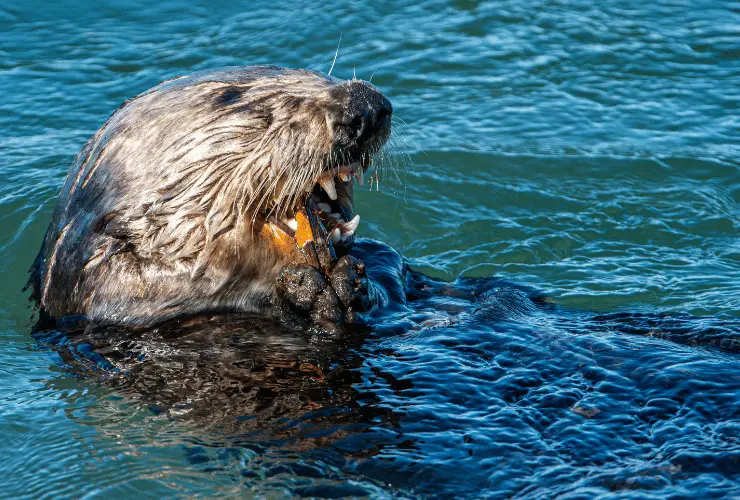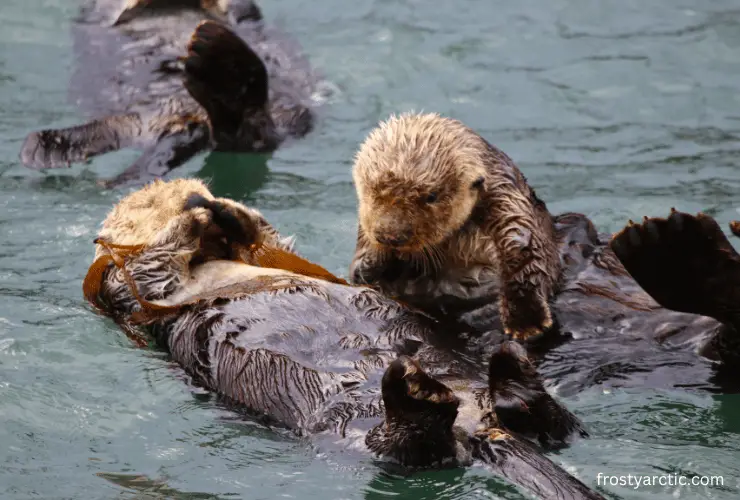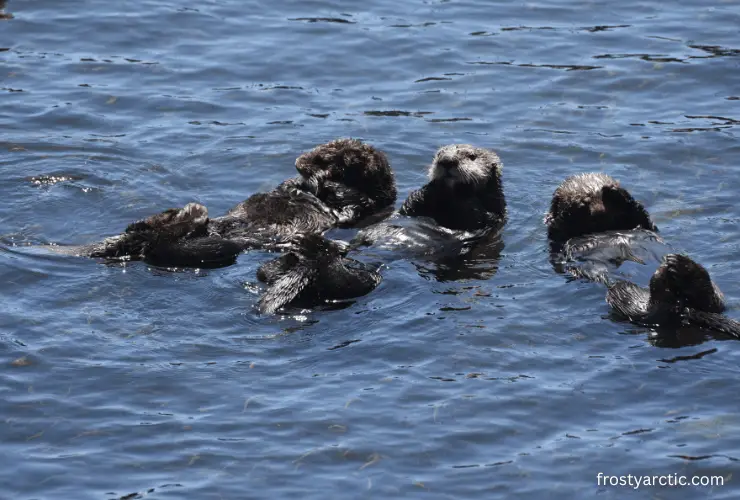Sea otters are aquatic mammals that give birth to live young; they don’t lay eggs. They are viviparous, which is a common method of reproduction in mammals. Female sea otters experience internal fertilization and carry their offspring internally throughout the gestation period. The embryo receives all the nourishment internally from the mother.
The complete internal development of the sea otter pup allows the mother to have an emotional bond with her baby. Female sea otters nurse their pups and provide them with a protected environment.
Sea otters are carnivorous mammals belonging to the family Mustelidae. They have a playful nature and an interesting reproductive pattern. In this article, we will unfold their intricate reproductive process and enchanting courtship behaviors.
Do Sea Otters Lay Eggs or Give Birth?
Female sea otters give birth to fully mature young ones. Sea Otters belong to the lineage of birth-giving aquatic mammals. They conceive the baby internally after mating.

Once the embryo of the female sea otter implants in the uterus, a placenta develops to deliver nutrients to the fetus. When the fetus within the mother completes its development, sea otters give birth.
Giving birth to live young is more beneficial for the sea otter, as this process ensures the species’ survival. The baby develops in protected conditions inside the mother and does not face any threats from hunting.
Although sea otters breed all year, there are peak mating seasons when the population is at its highest. Different populations of sea otters have different peak breeding seasons according to the favorable conditions of their region.
| Sea Otters | Scientific Name | Location | Peak Breeding Months | Source |
| Northern Sea Otters | Enhydra lutris kenyoni | Alaska, British Columbia | May and June | ~ Source |
| Southern Sea Otters | Enhydra lutris nereis | California and Baja California | March and September | ~ Source |
| Asian Sea Otters | Enhydra lutris lutris | Russia and Japan |
How Do Sea Otters Give Birth?
Female Sea Otters attain maturity for mating and reproduction at around 4 to 5 years old. Sea otters are polygamous, which means they mate with multiple partners throughout their lives. ~Source.
Did you know? The act of mating among Sea Otters is intense and lasts for about 10 to 30 minutes.
The gestation period of sea otters typically lasts from 4 to 6 months. However, the gestation period can be variable because female Sea otters have the ability to delay implantation. It means that after the fertilization of the egg, females can prevent it from implanting in the uterus. Once the environmental conditions become favorable, the fertilized egg attaches to the uterus and develops.

Sea otters give birth to only one baby in one pregnancy. It is rare for Sea Otters to give birth to multiple pups. In the case of a twin pregnancy, only one baby survives. Unlike the other otter species, Sea Otters give birth in the water. Pups of Sea Otters are born with open eyes, developing teeth, and a thick fur coat.
| Characteristics | Female Sea Otter | Male Sea Otter |
| Sexual Maturation | 4 to 5 years old | 3 to 6 years old |
| Starts Copulation | Right after sexual maturation | A few years after the sexual maturation |
| Mating Partner | Polygamous | Polygamous |
| Nurturing of Offspring | Mother sea otter takes care of the pup | Father sea otter does not develop any bond with the pup |
What Are Baby Sea Otters Called?
Baby Sea Otters are known as pups. These pups are born with a body weight of about 3 to 5 pounds. Newly born pups depend on their mothers for feeding, care, protection, and survival. Pups of sea otters are born with a dense fur coat that causes them to float on the water’s surface.
The mother teaches the pup to swim, hunt, forage, and dive. Sea otter pups pick up all these crucial survival skills within a short period of time. Still, the pup depends on the mother for a period of about 6 months. As the pup grows more mature, the mother and the pup form a close attachment. Sea Otter pups have a charming and playful nature.
Do Sea Otters Love Their Babies?
Mother sea otters love their babies and develop a beautiful, strong bond with them. They are very defensive about protecting their little pups. Sea Otter mothers have an unmatched love and devotion for their pups. They feed, nurture, and raise their offspring with undivided attention and care.
Mothers also attentively groom their pups by brushing their fur, scratching off the loose fur, removing the excess water from the fur, and blowing air into the fur for insulation.

They cradle the pups on their chests while floating in the water and hold their babies while sleeping so that they do not float away.
The mother ties her pup to the kelp so it will not float away when she dives into the water to forage (look for wild food resources). The pup keeps bobbing on the surface of the water until the mother comes back. The precious bond between sea otter mothers and their babies is unbreakable.
What Do Sea Otters Feed Their Babies?
Sea Otters exclusively nurse their babies with their mother’s milk for several months while they are growing. Milk is the primary source of nutrients for the pups for the first 6 to 9 months. This milk is filled with many essential nutrients and fats required for the baby’s optimal growth.
Once the pup matures, the mother introduces solid food by giving it bits and scraps of her food. In their diet, sea otters consume a wide range of small aquatic animals, such as sea urchins, tiny fish, snails, clams, crabs, and others. In this way, pups gradually transition from milk to solid foods.
Sea Otter mothers also start teaching their pups the skills of diving and foraging. The baby practices diving under the supervision of its mother and retrieves little objects from the sea. The pup gradually builds its skill at foraging by imitating its mother’s actions.
Do Sea Otters Produce Milk?
Yes, Sea Otters produce milk for nursing their pups. Sea Otters are mammals that are characterized as having milk-producing mammary glands. The female sea otter has two abdominal nipples through which she feeds her pup. She holds the pup on her belly while it is feeding.
Sea Otters are known for nursing their offspring for 6 to 8 months. 20% to 25% of female sea otter milk’s constituents are fat. This fat-rich milk is necessary for the pup’s proper development and provides energy for metabolic functions.
Growing sea otter pups rely solely on their mother’s milk and nurse frequently. Therefore, the mother has to eat more than a quarter of her body weight to produce more calories in the milk.
FAQs
Do Sea Otters Have Kittens?
No, sea otters do not have kittens. The offspring of sea otters are called pups. The pup completely depends on the mother for its grooming and feeding. The mother develops a unique bond of tenderness and affection with her pup.
How many eggs do Sea otters lay?
Sea otters do not lay eggs. They are birth-giving mammals. Sea Otters have a remarkable reproductive pattern. They give birth to one baby at a time.
Are sea otters viviparous or oviparous?
Sea otters are viviparous. Viviparity is a mode of reproduction in mammals. This mode of reproduction is characterized by internal fertilization and internal development of the fetus. The mother gives birth to the pup once the gestation period is completed.
Conclusion
Sea otters are playful and adorable aquatic mammals who experience the miracle of giving birth. The mother sea otter cares deeply for her young and is in charge of providing them with all of their food. Female sea otters have strong maternal instincts that cause them to have a strong connection with their pups. She ensures the protection of her pup in every regard.
Mother teaches the young sea otter every survival skill necessary, including swimming, hunting, diving, and foraging. The pup gradually learns everything from its mother and ultimately becomes independent after 9 to 12 months. The biology of sea otters is fascinating, and they are fascinating animals.



3 thoughts on “Do Sea Otters Give Birth or Lay Eggs?”